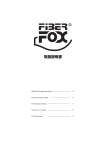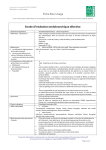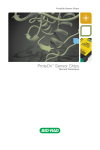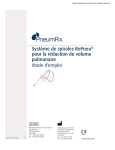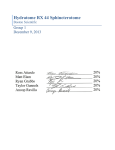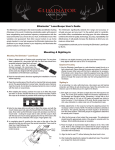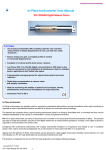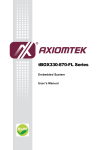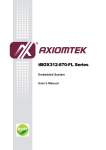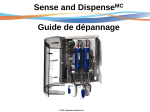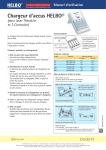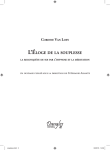Download Bi-lang Optiguide IFU 8pp
Transcript
fibersdirect.com REF: DCYL210 DCYL225 DCYL215 DCYL250 DCYL220 O P T I G U I D E ™ Fiber Optic (DCYL Cylindrical Diffuser Series) INSTRUCTIONS FOR USE Single use only - Do not re-sterilize MC FIBRE OPTIQUE OPTIGUIDE (Diffuseur Cylindrique Série DCYL) INSTRUCTIONS D’UTILISATION À usage unique – Ne pas restériliser Model No. / Diffuser Length / Modèle No. Longueur du diffuseur _________________________________________________________________________________________________________ DCYL __________210 _________________________________________________1.0cm ______________________________________________ DCYL __________215 _________________________________________________1.5cm ______________________________________________ DCYL 220 2.0cm _________________________________________________________________________________________________________ Manufactured in the USA for: fibersdirect.com, One Dundee Park, Suite 5/6 Andover, MA 01810 Tel: 1 978 475 7771 ■ Fax: 1 978 475 8488 D I O M E D is a Trademark of D I O M E D Inc. OPTIGUIDE is a Trademark owned by D I O M E D Inc. PHOTOFRIN is a Registered Trademark of Axcan Pharma, Inc. Lambda Plus is a Trademark of Coherent Inc. KTP/532 is a Registered Trademark of Laserscope. KTP/YAG is a Trademark of Laserscope © D I O M E D Inc., 2001 All rights reserved. Printed in UK Covered under USA Patents 5,074,632 and 5,431,647 DCYL __________225 _________________________________________________2.5cm ______________________________________________ DCYL 250 5.0cm _________________________________________________________________________________________________________ ™ ® ™ Fabriqué aux É.-U. pour : fibersdirect.com, One Dundee Park, Suite 5/6, Andover MA 01810, États-Unis Tél: 1 978 475 7771 ■ Télec: 1 978 475 8488 D I O M E D est une marque de commerce de D I O M E D Inc. OPTIGUIDEMC est une marque de commerce propriété de D I O M E D Inc. PHOTOFRIN® est une marque déposée de Axcan Pharma, Inc. Lambda PlusMC est une marque de commerce de Coherent Inc. KTP/532® est une marque déposée de Laserscope. KTP/YAGMC est une marque de commerce de Laserscope © D I O M E D Inc., 2001 Tous droits réservés. Imprimé au Royaume-Uni Couvert par les brevets américains 5,074,632 et 5,431,647 PP/0825 Issue 1 US Federal Law restricts this device to sale by or on the order of a physician. com fibersdirect ™ ® Selon la loi fédérale américaine et les lois françaises, cet appareil ne peut être utilisé que par un médecin. fibersdirect.com One Dundee Park, Suite 5/6 Andover, MA 01810 Reorder from Customer Service: Tel: 1-866-4FIBERS (434-2377) ■ Fax: 1-866-5FIBERS (534-2377) http://www . fibersdirect . com Pour une nouvelle commande, s’adresser à : Tél: 1-866-4FIBERS (434-2377) ■ Télec: 1-866-5FIBERS (534-2377) http://www . fibersdirect . com PRODUCT DESCRIPTION The DCYL series OPTIGUIDE™ Fiber Optic Diffuser is a light delivery system consisting of a 400µm coated silica laser fiber, a proximal SMAtype laser connector, and a distal light diffusing tip. Equivalent Equivalent Model Diffuser Type Power Coherent Laserscope No: Length Output Cat. No. Cat. No. _________________________________________________________________________________________________________ DCYL210 1.0 cm Cylindrical ___________________________________________________400 _______mW _________10-9011 ____________________10-9001 __________________ DCYL215 _________________1.5 ______cm __________Cylindrical __________________600 _______mW _________10-9012 ____________________10-9002 __________________ DCYL220 2.0 cm Cylindrical 800 mW 10-9013 _______________________________________________________________________________________10-9003 __________________ DCYL225 _________________2.5 ______cm __________Cylindrical __________________1000 _________mW _______10-9014 ____________________10-9004 __________________ DCYL250 5.0 cm Cylindrical 2000 mW 10-9017 _______________________________________________________________________________________10-9007 __________________ FOR SINGLE USE ONLY THESE INSTRUCTIONS ARE APPLICABLE ONLY TO THE OPTIGUIDE™ FIBER OPTIC (CYLINDRICAL) DIFFUSER USED IN CONJUNCTION WITH PHOTOFRIN ® PORFIMER SODIUM AND APPROVED LASER SYSTEMS IN PDT. INSTRUCTIONS FOR USE OF THE FIBER OPTIC, PHOTOFRIN ®, AND THE SELECTED LASER SYSTEM SHOULD BE READ CAREFULLY BEFORE USE. USE OF INCOMPATIBLE LASERS THAT ALTER THE REQUIRED OUTPUT CHARACTERISTICS OF LIGHT FOR THE PHOTOACTIVATION OF PHOTOFRIN ® COULD RESULT IN INCOMPLETE TREATMENT DUE TO PARTIAL PHOTOACTIVATION OF PHOTOFRIN ®, OVERTREATMENT DUE TO OVERACTIVATION OF PHOTOFRIN ®, DAMAGE TO SURROUNDING NORMAL TISSUE, AND/OR DAMAGE TO THE FIBER OPTIC DIFFUSER WHICH COULD ADDITIONALLY CREATE AN OPTICAL HAZARD FOR MEDICAL PERSONNEL AND/OR THE PATIENT. ALWAYS WEAR APPROVED PROTECTIVE EYEWEAR SUITABLE FOR THE WAVELENGTH IN USE DURING LASER LIGHT DELIVERY. AVOID EYE OR SKIN EXPOSURE TO DIRECT OR SCATTERED RADIATION. DO NOT VIEW THE BEAM DIRECTLY, EVEN WHILE WEARING PROTECTIVE EYEWEAR. PROVIDE EYE PROTECTION FOR PATIENT IN ADDITION TO ALL OPERATING ROOM STAFF. Precautions CAUTION FEDERAL (USA) LAW RESTRICTS THIS DEVICE TO SALE BY OR ON THE ORDER OF A PHYSICIAN. CONTENTS OF PACKAGE This package contains one sterile fiber optic diffuser designed to transmit and uniformly distribute light energy radially over the specified length of the diffuser. The OPTIGUIDE™ Fiber Optic Diffuser is designed to couple to an approved 630 nm (red light) laser system via an SMA-905 laser connector. INDICATIONS FOR USE The OPTIGUIDE™ Fiber Optic Diffuser is designed for use in Photodynamic ® Therapy with PHOTOFRIN (porfimer sodium) for Injection for: ■ palliation of patients with completely obstructing esophageal cancer, or of patients with partially obstructing esophageal cancer who, in the opinion of their physician, cannot be satisfactorily treated with Nd:YAG laser therapy, ■ reduction of obstruction and palliation of symptoms in patients with completely or partially obstructing endobronchial nonsmall cell lung cancer (NSCLC), ■ treatment of microinvasive endobronchial NSCLC in patients for whom surgery and radiotherapy are not indicated. ■ ablation of high-grade dysplasia (HGD) in Barrett’s esophagus (BE) among patients who are not candidates for esophagectomy. The OPTIGUIDE™ Fiber Optic Diffuser is designed for endoscopic positioning for delivery of laser light and should only be used with ® approved lasers. Refer to the PHOTOFRIN Package Insert for complete instructions concerning the drug. WARNINGS THESE INSTRUCTIONS ARE INTENDED FOR USE BY PHYSICIANS WHO HAVE BEEN TRAINED IN THE USE OF PHOTOFRIN® IN PHOTODYNAMIC THERAPY (PDT). STERILIZED WITH ETHYLENE OXIDE GAS. STERILE ONLY IF THE PROTECTIVE BAG IS NOT OPENED, DAMAGED OR BROKEN. DO NOT RESTERILIZE. 2 Fragile: Contains glass fiber that may break if handled roughly or bent sharply. Do not clamp the fiber directly. Store in a cool dry place. Follow the Laser Operator Manual instructions for setup and operation. Do not exceed maximum laser power setting without investigating the cause for the apparent high energy loss (see PREPARATION FOR USE). Assure that the laser light is not being transmitted when the diffuser is removed from the power meter. Avoid inadvertent photoactivation of non-target tissue. Assure that the laser light is not being transmitted when the diffuser is removed from the treatment site. INSTRUCTIONS FOR USE APPROVED LASER SYSTEMS: The following laser systems have been tested in PDT for compatibility ® with the OPTIGUIDE™ Fiber Optic Diffusers and PHOTOFRIN (porfimer sodium) and are approved for delivery of a stable power output at a wavelength of 630 ±3 nm. Coherent, Inc., Santa Clara, CA PDL1 Lambda Plus™ Laser System Coherent, Inc., Santa Clara, CA PDL2 Lambda Plus™ Laser System D I O M E D Inc., Andover, MA D I O M E D 630 PDT Laser Model T2 USA (for US and Canada) Laserscope, San Jose, CA ® KTP/532 Surgical Laser System (Series 800) in combination with Laserscope Model 630 or Model 630 XP Dye Modules Laserscope, San Jose, CA ® KTP/YAG Surgical Laser System (Series 800) in combination with Laserscope Model 630 or Model 630 XP Dye Modules 3 NOTE Fiber Optic Diffuser Selection ■ THE INPUT CHARACTERISTICS OF THE FIBER AND THE OUTPUT CHARACTERISTICS OF THE LASER HAVE BEEN TESTED TO ASSURE THAT THEY ARE OPTICALLY MATCHED TO PRODUCE UNIFORM LIGHT DISTRIBUTION FROM THE DIFFUSER AS REQUIRED FOR THE PHOTO-ACTIVATION OF PHOTOFRIN ® . ■ THE USE OF THE OPTIGUIDE™ FIBER OPTIC DIFFUSER WITH UNAPPROVED LASERS COULD ALTER THE OUTPUT CHARACTERISTICS OF THE FIBER (SEE WARNINGS). ■ CERTAIN PULSED LASERS WITH HIGH PEAK POWERS ARE NOT COMPATIBLE WITH THE OPTIGUIDE™ FIBER OPTIC DIFFUSER. Laser Safety Use protective eyewear specifically rated for lasers operating over the range of 630 ± 3 nm. Provide approved eye protection for patient in addition to all operating room staff (see WARNINGS). Comply with facility laser safety requirements. Follow the laser manufacturer’s operator manual instructions for setup and operation. Do not exceed maximum laser power setting without investigating the cause for the apparent high energy loss (see PREPARATION FOR USE). OPTIGUIDE™ cylindrical diffusers are available in several lengths. The choice of diffuser length depends on the length of the tumor. Select an appropriate diffuser length to avoid exposure of nonmalignant tissue to light and to minimize overlapping of previously treated malignant tissue. Overlapping could result in unintended light overdose. Increased symptoms and damage to normal tissue might be expected following an overdose of light. Light doses of two to three times the recommended dose have been administered to a few patients with superficial endobronchial tumors. One patient experienced life-threatening dyspnea and the others had no notable complications. Tumors with lengths that differ from available diffuser lengths may require multiple use of a single OPTIGUIDE™ Fiber Optic Diffuser or the use of two or more OPTIGUIDE™ Fiber Optic Diffusers of differing lengths. The total power output from the diffuser, as measured by a suitable integrating sphere power meter, is set to: 400 mW x cm diffuser length. Diffusers or combinations of diffusers should be selected to minimize patient treatment time. Table 1 provides examples for various tumor sizes and diffuser lengths. Table 1. Examples of Use of OPTIGUIDE™ Cylindrical Diffusers Esophageal Cancer (300 J/cm) Tumor Length Min: Sec Total Time Min: Sec Total Time Per _____Segment ______________________(min: ______sec) __________________________Per ____Segment ______________________(min: ______sec) ______________ Diffuser Diffuser Segment Fiber Optic ______________________Model ________________________Length _________________Number ___________________Power _______Output ________(mW) ________ 1.0cm DCYL 210 1.0cm 1 400 _________________________________________________________________________________________________________ 2.0cm ______________________DCYL _________220 _______________2.0cm _________________1___________________800 _______________________ 3.0cm DCYL 215 1.5cm 1 600 ______________________DCYL _________215 _______________1.5cm _________________2___________________600 _______________________ 5.0cm DCYL 250 5.0cm _______________________________________________________________1___________________2000 _______________________ 7.0cm DCYL 250 5.0cm 1 2000 DCYL 220 2.0cm 2 800 Endobronchial Cancer a (200 J/cm) 12.30 ___________________________12.30 ________________________________8.20 __________________________8.20 ____________________ 12.30 12.30 8.20 _____________________________________________________________________________________8.20 ____________________ 12.30 8.20 25.00 16.40 12.30 8.20 _________________________________________________________________________________________________________ 12.30 ___________________________12.30 ________________________________8.20 __________________________8.20 ____________________ } 12.30 } 25.00 12.30 } 8.20 8.20 a Dosimetry ® Photoactivation of PHOTOFRIN is controlled by the total light dose delivered. In the treatment of esophageal cancer, a light dose of 300 J/cm of diffuser length should be delivered. In the treatment of endobronchial cancer, 200 J/cm of diffuser length should be delivered for superficial or obstructing tumors. In the pre-treatment of nodules or for the treatment of a "skip" area in HGD in BE, 50 J/cm of diffuser length should be delivered. For this DCYL series of OPTIGUIDE™ Fiber Optic (Cylindrical) Diffusers, the following specific light dosimetry equation applies: Treatment Time = Tissue Dose (J/cm) (Seconds) Power (W/cm) } 16.40 for superficial or obstructing tumors Short fiber optic diffusers (≤ 2.5 cm) are used to pre-treat nodules or for the re-treatment of “skip” areas after the first light session. For this treatment a light intensity of 400 mW/cm is used. Table 2 lists appropriate fiber optic power outputs and treatment times using a light intensity of 400 mW/cm. Table 2. Short Fiber Optic Diffusers Used to Deliver 50 J/cm of Diffuser Length at Light Intensity of 400 mW/cm Diffuser Length Required Power Treatment Time Treatment Time A _(cm) ________________________Output ________from ______Diffuser _____________________(sec) ________________________(min:sec) _____________________ _1.0cm ________________________0.4 ___________________________________125 ________________________2:05 _____________________ _1.5cm ________________________0.6 ___________________________________125 ________________________2:05 _____________________ 2.0cm _________________________0.8 ___________________________________125 ________________________2:05 _____________________ 2.5cm 1.0 125 2:05 eg. (esophageal cancer) Treatment Time = 300 J/cm 0.4 W/cm A = 750 seconds (12 minutes, 30 seconds) 4 As measured by immersing the diffuser into the cuvet in the power meter and slowly increasing the laser power. 5 PREPARATION FOR USE PROCEDURE 1. Prepare the laser system for delivery of 630 ± 3 nm light as indicated in the appropriate laser system operator manual. Select minimal power settings. 1. Thread the OPTIGUIDE™ Fiber Optic Diffuser into the working channel of the selected endoscope or bronchoscope. 2. Position the diffuser as required to treat the tumor. 2. Aseptically remove the OPTIGUIDE™ Fiber Optic Diffuser from the sterile bag. Do not use if there are visible signs of damage or breakage. Hang or secure the fiber spool in the sterile field. 3. Remove the SMA connector from the spool and pull out enough fiber to reach the laser system optical coupler. 4. Hold the SMA connector without touching the polished end. Seat the connector into the optical coupler and secure by turning the SMA nut until it is finger tight. Do not over tighten. 5. Gently pull the diffuser and fiber from the opposite side of the spool. Avoid touching the diffuser. 6. The power output from the OPTIGUIDE™ Fiber Optic Diffuser should be measured using a suitable integrating sphere power meter. The power meter should be able to measure laser power up to 3.0 W at 630 ± 3 nm. Adjust the laser power setting to obtain the specified power output for the specific diffuser model. Model No: Maximum Fiber Optic Power Output _________________________________________________________________________________________________________ _DCYL210 _______________________________________________________400 _______mW __________________________________________ DCYL215 ________________________________________________________600 _______mW __________________________________________ DCYL220 ________________________________________________________800 _______mW __________________________________________ DCYL225 1000 ________________________________________________________________mW _________________________________________ DCYL250 _______________________________________________________2000 _________mW _________________________________________ NOTE ■ DO NOT EXCEED MAXIMUM LASER POWER SETTING WITHOUT INVESTIGATING THE CAUSE FOR THE APPARENT HIGH ENERGY LOSS. EXCESS POWER BEYOND LEVELS SPECIFIED MAY DAMAGE THE FIBER OPTIC DIFFUSER. POSSIBLE CAUSES MAY INCLUDE THE WRONG LASER SOURCE, LASER OUT OF ALIGNMENT, DEFECT OR BREAK IN THE FIBER OPTIC, INCORRECT SETTING ON THE POWER METER, OR MALFUNCTION OF THE POWER METER. ■ ASSURE THAT THE LASER LIGHT IS NOT BEING TRANSMITTED WHEN THE DIFFUSER IS REMOVED FROM THE POWER METER (SEE PRECAUTIONS). 7. The fiber optic power output is now adjusted. Do not adjust laser power settings. The OPTIGUIDE™ Fiber Optic Diffuser is now ready for use. Repeat PREPARATION Steps 1 through 7 if a different diffuser is used. 6 3. Begin delivery of the laser light and expose the treatment site for the appropriate time for each treated segment. Do not move the diffuser during the exposure period. 4. Stop laser light delivery. NOTE ■ AVOID INADVERTENT PHOTOACTIVATION OF NON-TARGET TISSUE. ASSURE THAT THE LASER LIGHT IS NOT BEING TRANSMITTED WHEN THE DIFFUSER IS REMOVED FROM THE TREATMENT SITE (SEE PRECAUTIONS). 5. If multiple segments are to be treated, reposition the fiber optic diffuser in the next treatment position. Avoid over-dosing with laser light by minimizing overlapping of treatment areas. 6. Readjust and/or confirm the power level each time a different fiber optic diffuser is used or if the fiber optic in use is disconnected and reconnected to the laser. Disclaimer of Warranties D I O M E D Inc. warrants that reasonable care has been used in the manufacture of this device. The warranty printed above is the only warranty applicable to this purchase. All other warranties, express or implied, including, but not limited to, the implied warranties of merchantability and fitness for a particular purpose are disclaimed. It is understood and agreed that seller’s liability whether in contract, in tort, under any warranty, in negligence, or otherwise shall not exceed the return of the amount of the purchase price paid by purchaser. Under no circumstances shall seller be liable for special, indirect, or consequential damages. The price stated for the equipment is a consideration in limiting seller’s liability. No action, regardless of form, arising out of the transactions under this agreement may be brought by purchaser more than one year after the cause of action has accrued. No representative of D I O M E D Inc. may change any of the foregoing or assume any additional liability or responsibility in connection with this device. 7 DESCRIPTION DU PRODUIT Le diffuseur à fibre optique OPTIGUIDEMC série DCYL est un dispositif d’administration de lumière, composé d’une fibre laser de silice enrobée de 400 µm, d’un connecteur laser proximal de type SMA et d’une pointe distale de diffusion de lumière. No. de Longueur Type Puissance Référence Référence modèle du de sortie équivalente équivalente diffuseur Coherent Laserscope _________________________________________________________________________________________________________ DCYL210 1.0 cm cylindrique 400 mW 10-9011 _________________________________________________________________________________________10-9001 ________________ DCYL215 ________________1.5 _____cm ____________cylindrique ________________600 _______mW ____________10-9012 _____________________10-9002 ________________ _DCYL220 _______________2.0 _____cm ____________cylindrique ________________800 _______mW ____________10-9013 _____________________10-9003 ________________ _DCYL225 _______________2.5 _____cm ____________cylindrique ________________1000 ________mW ___________10-9014 _____________________10-9004 ________________ _DCYL250 _______________5.0 _____cm ____________cylindrique ________________2000 ________mW ___________10-9017 _____________________10-9007 ________________ À USAGE UNIQUE CES INSTRUCTIONS SONT APPLICABLES UNIQUEMENT AU DIFFUSEUR (CYLINDRIQUE) À FIBRE OPTIQUE OPTIGUIDEMC UTILISÉ CONJOINTEMENT À PHOTOFRIN® PORFIMÈRE SODIQUE ET AUX SYSTÈMES LASER AGRÉÉS EN TPD. LES INSTRUCTIONS D’UTILISATION DE LA FIBRE OPTIQUE, DE PHOTOFRIN® ET DU SYSTÈME LASER SÉLECTIONNÉ DOIVENT ÊTRE LUES AVEC ATTENTION AVANT L’UTILISATION. L’UTILISATION DE LASERS INCOMPATIBLES, MODIFIANT LES CARACTÉRISTIQUES DE RENDEMENT LUMINEUX REQUISES POUR LA PHOTOACTIVATION DE PHOTOFRIN®, PEUT ENTRAÎNER UN TRAITEMENT INCOMPLET EN RAISON D’UNE PHOTOACTIVATION PARTIELLE DE PHOTOFRIN®, UN TRAITEMENT EXCESSIF EN RAISON D’UNE SURACTIVATION DE PHOTOFRIN®, UNE LÉSION DES TISSUS NORMAUX ENVIRONNANTS OU UNE DÉTÉRIORATION DU DIFFUSEUR À FIBRE OPTIQUE, SUSCEPTIBLE EN OUTRE D’OCCASIONNER UN RISQUE OCULAIRE POUR LE PERSONNEL MÉDICAL ET LES PATIENTS. TOUJOURS PORTER DES ÉQUIPEMENTS OCULAIRES DE PROTECTION AGRÉÉS ET ADAPTÉS À LA LONGUEUR D’ONDE UTILISÉE DURANT L’ADMINISTRATION D’UN FAISCEAU LASER. ÉVITER TOUTE EXPOSITION DES YEUX OU DE LA PEAU À UN RAYONNEMENT DIRECT OU DIFFUSÉ. NE PAS OBSERVER LE FAISCEAU DIRECTEMENT, MÊME EN PORTANT DES ÉQUIPEMENTS OCULAIRES DE PROTECTION. FOURNIR UNE PROTECTION OCULAIRE AUX PATIENTS AINSI QU’AU PERSONNEL EN SALLE D’OPÉRATION. ATTENTION Précautions SELON LA LOI FÉDÉRALE AMÉRICAINE ET LES LOIS FRANÇAISES, CET APPAREIL NE PEUT ÊTRE UTILISÉ QUE PAR UN MÉDECIN. Fragile : Contient de la fibre de verre susceptible de se briser en cas de manipulation trop brusque ou de courbure excessive. Ne pas clamper la fibre directement. Conserver dans un endroit frais et sec. CONTENU DE L’EMBALLAGE Cet emballage contient un diffuseur à fibre optique stérile, conçu pour transmettre et répartir uniformément l’énergie lumineuse de manière radiale sur la longueur spécifiée du diffuseur. Le diffuseur à fibre optique OPTIGUIDEMC est conçu pour être couplé à un système laser agréé de 630 nm (lumière rouge) par le biais d’un connecteur laser SMA-905. INDICATIONS D’UTILISATION Le diffuseur à fibre optique OPTIGUIDEMC est conçu pour être utilisé en thérapie photodynamique avec PHOTOFRIN® (porfimère sodique) pour Injection, dans les indications suivantes: ■ traitement des patients atteints d’un cancer de l’œsophage complètement occlusif ou des patients souffrant d’un cancer de l’œsophage partiellement occlusif qui, de l’avis de leur médecin, ne peuvent être traités de manière satisfaisante par thérapie au laser Nd:YAG, ■ réduction de l’obstruction et traitement palliatif des symptômes chez les patients atteints d’un cancer du poumon endobronchique non à petites cellules avec obstruction complète ou partielle, ■ traitement du cancer du poumon endobronchique micro-invasif non à petites cellules chez les patients pour lesquels la chirurgie et la radiothérapie ne sont pas indiquées. Le diffuseur à fibre optique OPTIGUIDEMC est conçu pour un positionnement endoscopique destiné à l’administration d’un rayonnement laser et il doit être utilisé uniquement avec les lasers agréés. Se référer à la notice contenue dans l’emballage de PHOTOFRIN® pour des instructions complètes concernant le médicament. MISES EN GARDE CES INSTRUCTIONS SONT DESTINÉES À DES MÉDECINS FORMÉS À L’UTILISATION DE PHOTOFRIN® EN THÉRAPIE PHOTODYNAMIQUE (TPD). Suivre les instructions du Manuel d’utilisation du laser pour son installation et son utilisation. Ne pas dépasser le réglage maximal de puissance laser sans rechercher la cause de toute importante perte énergétique apparente (voir PRÉPARATION À L’UTILISATION). S’assurer que le faisceau laser n’est pas en cours de transmission lorsque le diffuseur est retiré du potentiomètre. Éviter la photoactivation par inadvertance de tout tissu autre que les tissus cibles. S’assurer que le faisceau laser n’est pas en cours de transmission lorsque le diffuseur est retiré de la zone de traitement. INSTRUCTIONS D’UTILISATION SYSTÈMES LASER AGRÉÉS : Les systèmes laser suivants ont fait l’objet de tests dans le cadre d’une TPD avec de vérifier leur compatibilité avec les diffuseurs à fibre optique OPTIGUIDEMC et PHOTOFRIN® (porfimère sodique) et ils ont été approuvés pour la délivrance d’une puissance de sortie stable à une longueur d’onde de 630 ± 3 nm. Coherent, Inc., Santa Clara, CA, É.-U. Système Laser PDL1 Lambda PlusMC Coherent, Inc., Santa Clara, CA, É.-U. Système Laser PDL2 Lambda PlusMC D I O M E D Inc., Andover, MA, É.-U. Laser D I O M E D 630 TPD modèle T2 USA (pour les É.-U. et le Canada) Laserscope, San Jose, CA, É.-U. Système Laser Chirurgical KTP/532® (série 800) en association au Laserscope modèle 630 ou modèle 630 XP modules à colorant STÉRILISÉ À L’OXYDE D’ÉTHYLÈNE. STÉRILE UNIQUEMENT SI LA POCHE DE PROTECTION N’EST PAS OUVERTE, ENDOMMAGÉE OU PERCÉE. NE PAS RESTÉRILISER. Laserscope, San Jose, CA, É.-U. Système Laser Chirurgical KTP/YAG® (série 800) en association au Laserscope modèle 630 ou modèle 630 XP modules à colorant 8 9 REMARQUE Sélection du Diffuseur à Fibre Optique ■ LES CARACTERISTIQUES D’ENTREE DE LA FIBRE ET LES CARACTERISTIQUES DE SORTIE DU LASER ONT ETE TESTEES, AFIN DE GARANTIR QU’ILS SONT OPTIQUEMENT COMPATIBLES POUR PRODUIRE UNE DISTRIBUTION UNIFORME DE LA LUMIERE A PARTIR DU DIFFUSEUR, COMME L’EXIGE LA PHOTOACTIVATION DE PHOTOFRIN®. ■ L’UTILISATION DU DIFFUSEUR À FIBRE OPTIQUE OPTIGUIDEMC AVEC DES LASERS NON AGRÉÉS RISQUE D’ALTÉRER LES CARACTÉRISTIQUES DE SORTIE DE LA FIBRE (VOIR MISES EN GARDE). ■ CERTAINS LASERS PULSÉS À PUISSANCE DE POINTE ÉLEVÉE NE SONT PAS COMPATIBLES AVEC LE DIFFUSEUR À FIBRE OPTIQUE OPTIGUIDEMC. Sécurité Laser Utiliser des équipements oculaires de protection spécifiquement adaptés aux lasers opérant au delà de la fourchette de 630 ± 3 nm. Fournir une protection oculaire agréée aux patients ainsi qu’au personnel en salle d’opération (voir MISES EN GARDE). Respecter les consignes de sécurité laser de l’établissement. Suivre les instructions fournies par le fabricant dans le Manuel d’utilisation du laser pour son installation et son utilisation. Ne pas dépasser le réglage maximal de puissance laser sans rechercher la cause de toute importante perte énergétique apparente (voir PRÉPARATION À L’UTILISATION). Les diffuseurs cylindriques OPTIGUIDEMC sont disponibles en plusieurs longueurs. Le choix de la longueur du diffuseur dépend de la longueur de la tumeur. Sélectionner une longueur de diffuseur appropriée afin d’éviter l’exposition de tissus non malins au rayonnement et de minimiser le chevauchement de tissus malins précédemment traités. Le chevauchement pourrait entraîner un surdosage lumineux par inadvertance. Une aggravation des symptômes et l’apparition de lésions sur des tissus normaux peuvent être attendues suite à un surdosage lumineux. Des doses lumineuses équivalentes à deux à trois fois la dose recommandée ont été administrées à quelques patients présentant des tumeurs bronchopulmonaires superficielles. Un patient a présenté une dyspnée mettant en jeu le pronostic vital et les autres n’ont connu aucune complication notable. Les tumeurs présentant des longueurs différentes de celles disponibles pour les diffuseurs peuvent nécessiter l’utilisation répétée d’un unique diffuseur à fibre optique OPTIGUIDEMC ou l’utilisation d’au moins deux diffuseurs à fibre optique OPTIGUIDEMC de longueurs différentes. La puissance de sortie totale du diffuseur, mesurée par un potentiomètre sphérique adapté, est réglée à : 400 mW x cm de longueur de diffuseur. Tableau 1. Exemples d’utilisation des diffuseurs cylindriques OPTIGUIDEMC Cancer de l’œsophage (300 J/cm) Cancer du poumon endobronchique (200 J/cm) a Longueur Modèle de Longueur Nombre Puissance de sortie de _ ___tumeur __________________diffuseur ________________________de___diffuseur ______________de___segments ________________de___fibre _____optique _________(mW) ______ Min: Sec Temps Total Min: Sec Temps Total _Par ____Segment ______________________(min: ______sec) _______________________Par ____Segment _____________________(min: _______sec) _________________ 1.0cm _ _____________________DCYL _________210 _______________1.0cm _________________1___________________400 _______________________ 2.0cm _ _____________________DCYL _________220 _______________2.0cm _________________1___________________800 _______________________ 3.0cm DCYL 215 1.5cm 1 600 ______________________DCYL _________215 _______________1.5cm _________________2___________________600 _______________________ 5.0cm DCYL 250 5.0cm _______________________________________________________________1___________________2000 _______________________ 7.0cm DCYL 250 5.0cm 1 2000 DCYL 220 2.0cm 2 800 _12.30 __________________________12.30 _____________________________8.20 _________________________8.20 ________________________ _12.30 __________________________12.30 _____________________________8.20 _________________________8.20 ________________________ 12.30 8.20 25.00 16.40 _12.30 _______________________________________________________8.20 _________________________________________________ 12.30 ___________________________12.30 _____________________________8.20 _________________________8.20 ________________________ 12.30 8.20 25.00 16.40 8.20 12.30 } } } } a Dosimétrie La photoactivation de PHOTOFRIN® est contrôlée par la dose totale de lumière administrée. Dans le traitement des cancers de l’œsophage, une dose de lumière de 300 J/cm de longueur de diffuseur doit être administrée. Dans le traitement des cancers du poumon endobronchiques, 200 J/cm de longueur de diffuseur doivent être administrés pour les tumeurs superficielles ou occlusives. Pour les diffuseurs (cylindriques) à fibre optique OPTIGUIDEMC de la série DCYL, l’équation spécifique suivante de dosimétrie de lumière s’applique : Les diffuseurs ou associations de diffuseurs doivent être sélectionnés afin de minimiser le temps de traitement du patient. Le Tableau 1 présente des exemples pour différentes tailles de tumeurs et longueurs de diffuseurs. Temps de traitement = Dose tissulaire (J/cm) (Secondes) Puissance (W/cm) ex. (cancer de l’œsophage) Temps de traitement = 300 J/cm 0.4 W/cm = 750 secondes (12 minutes, 30 secondes) 10 pour tumeurs superficielles ou occlusives 11 PRÉPARATION À L’UTILISATION MARCHE À SUIVRE 1. Préparer le système laser à l’administration d’un faisceau de 630 ± 3 nm en suivant les instructions du manuel d’utilisation du système laser approprié. Sélectionner les réglages de puissance minimaux. 1. Enfiler le diffuseur à fibre optique OPTIGUIDEMC dans le canal de l’endoscope ou du bronchoscope sélectionné. 2. Mettre le diffuseur en position requise afin de traiter la tumeur. 2. À l’aide d’une technique aseptique, retirer le diffuseur à fibre optique OPTIGUIDEMC de la poche stérile. Ne pas utiliser en cas de percement ou de dommages apparents. Suspendre ou fixer la bobine de fibre dans le champ stérile. 3. Retirer le connecteur SMA de la bobine et extraire une longueur suffisante de fibre pour atteindre le coupleur optique du système laser. 3. Commencer l’administration du rayonnement laser et exposer la zone de traitement pendant la durée appropriée pour chaque segment traité. Maintenir le diffuseur immobile durant la période d’exposition. 4. Arrêter l’administration du rayonnement laser. REMARQUE 4. Tenir le connecteur SMA sans toucher l’extrémité polie. Mettre le connecteur en place dans le coupleur optique et le fixer en serrant l’écrou SMA à la main. Ne pas trop serrer. 5. Tirer doucement le diffuseur et la fibre depuis le côté opposé de la bobine. Éviter de toucher le diffuseur. 6. La puissance de sortie du diffuseur à fibre optique OPTIGUIDEMC doit être mesurée à l’aide d’un potentiomètre sphérique adapté. Le potentiomètre doit pouvoir mesurer une puissance laser allant jusqu’à 3,0 W à 630 ± 3 nm. Ajuster le réglage de puissance laser afin d’obtenir la puissance de sortie précisée pour le modèle spécifique de diffuseur. ■ ÉVITER LA PHOTOACTIVATION PAR INADVERTENCE DE TOUT TISSU AUTRE QUE LES TISSUS CIBLES. S’ASSURER QUE LE FAISCEAU LASER N’EST PAS EN COURS DE TRANSMISSION LORSQUE LE DIFFUSEUR EST RETIRÉ DU SITE DE TRAITEMENT (VOIR PRÉCAUTIONS). 5. Si plusieurs segments doivent être traités, déplacer le diffuseur à fibre optique vers la position suivante de traitement. Éviter tout surdosage de rayonnement laser en minimisant le chevauchement des zones de traitement. 6. Réajuster et/ou confirmer le niveau de puissance chaque fois qu’un diffuseur à fibre optique différent est utilisé ou si la fibre optique utilisée est déconnectée et reconnectée au laser. Renonciation aux Garanties Modèle No.: Puissance de sortie maximale de la fibre optique _________________________________________________________________________________________________________ DCYL210 ____________________________________________________________400 _______mW ______________________________________ DCYL215 600 __________________________________________________________________mW _______________________________________ DCYL220 ____________________________________________________________800 ______mW _______________________________________ _DCYL225 __________________________________________________________1000 ________mW ______________________________________ DCYL250 ___________________________________________________________2000 ________mW ______________________________________ REMARQUE ■ NE PAS DÉPASSER LE RÉGLAGE MAXIMAL DE PUISSANCE LASER SANS RECHERCHER LA CAUSE DE TOUTE IMPORTANTE PERTE ÉNERGÉTIQUE APPARENTE. TOUT EXCÈS DE PUISSANCE AU DELÀ DES NIVEAUX SPÉCIFIÉS EST SUSCEPTIBLE D’ENDOMMAGER LE DIFFUSEUR À FIBRE OPTIQUE. PEUVENT FIGURER PARMI LES CAUSES POSSIBLES UNE SOURCE LASER INADAPTÉE, LE MAUVAIS ALIGNEMENT DU LASER, TOUT DÉFAUT OU DOMMAGE AFFECTANT LA FIBRE OPTIQUE, LE RÉGLAGE INCORRECT DU POTENTIOMÈTRE OU UN DYSFONCTIONNEMENT DU POTENTIOMÈTRE. ■ S’ASSURER QUE LE FAISCEAU LASER N’EST PAS EN COURS DE TRANSMISSION LORSQUE LE DIFFUSEUR EST RETIRÉ DU POTENTIOMÈTRE (VOIR PRÉCAUTIONS). 7. La puissance de sortie de la fibre optique est maintenant réglée. Ne pas ajuster les réglages de puissance laser. Le diffuseur à fibre optique OPTIGUIDEMC est maintenant prêt à l’emploi. Répéter les étapes de PRÉPARATION 1 à 7 en cas d’utilisation d’un diffuseur différent. 12 D I O M E D Inc. garantit qu’un soin raisonnable a été apporté à la fabrication de ce dispositif. La garantie imprimée ci-dessus est la seule garantie applicable à cet achat. Toute autre garantie est exclue, qu’elle soit explicite ou implicite, notamment mais non exclusivement toute garantie implicite de qualité commercialisable ou d'aptitude à une utilisation déterminée. Il est entendu et accepté que la responsabilité du vendeur, de par contrat, en droit civil, au regard de toute garantie, par négligence ou de toute autre manière, se limite au remboursement du prix d’achat payé par l’acheteur. Le vendeur ne saurait en aucun cas être tenu de verser des dommagesintérêts spéciaux ou indirects. Le prix stipulé pour l’équipement est pris en considération afin de limiter la responsabilité du vendeur. Aucune action, de quelque forme que ce soit, ayant trait aux transactions régies par cet accord, ne pourra être entreprise par l’acheteur au delà d’une année après la cause de ladite action. Aucun représentant de D I O M E D Inc. n’est autorisé à modifier en quoi que ce soit ce qui précède ou à assumer toute autre responsabilité en relation à ce dispositif. 13








